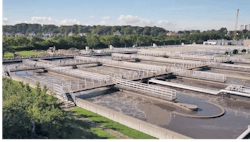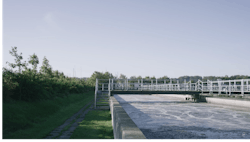Driving in Neutral
Bob Crossen is managing editor for WWD. Crossen can be reached at bcrossen@
sgcmail.com.
- Location: Arhaus, Denmark
- Size: 200,000 population
- Equipment: screens, aerators, blowers, sedimentation, sludge dewatering, digestion, variable speed drives, sensors
In Denmark, a water and wastewater authority has found a way to make its processes energy-neutral. In many modern plants, bringing outside fats, oils and grease (FOG) into the plant to generate more biogas that can be captured has been the key to finding energy neutrality success. At the Marselisborg Wastewater Treatment Plant, however, those external sources are not needed, nor are they used to increase energy production.
Mads Warming, water and wastewater sector global director for Danfoss, said the success at the Marselisborg Wastewater Treatment Plant lies in its efforts to reduce its energy consumption while optimizing all its processes.
“It’s a lot about a lot more sensors than you are normally seeing, and they’re being used for process control,” Warming said. “And then at the same point, if you do that right at the wastewater facility, you’ll get a double effect—an effect where you cut your energy consumption at the wastewater facility and, at the same time, increase your energy production.”
The sensors, he said, monitor everything in the plant and feed into the SCADA system, where software automates the processes. When telling people about the plant, he said he receives many skeptical looks and questions asking why so much trust is put into the sensors at the facility. The software, he said, is the backbone of that trust.
When it recognizes that something is not quite right or if a sensor flags an irregularity in the treatment process, it will automatically shift the plant to a standard mode that makes energy efficiency a secondary concern. When the operator of the plant returns and sees that the system is not running in high efficiency mode, that is when manual adjustments would come into play, Warming said.
With this system in place, he said the plant initially ran in high efficiency mode 60% of the time. However, the authority wanted to push that to the limit, and the operator found that with regular two-week maintenance and cleaning of particular sensors, the high efficiency mode could be active 98% of the time.
“He learned very fast that with his specific facility and his specific wastewater, what he needed to [ensure] that the sensors were operating all the time,” Warming said, noting that variable-speed drives installed on virtually everything with a motor also contributed to the plant’s energy neutral mission. “That means that they have full controllability of blowers and pumps and mixers and whatever you can think of, so the combination of having a lot more sensors and trusting them and variable-speed drives and some smart controls [have made this a success].”
What makes this so attractive, he added, is that this was all done to an existing facility running a traditional activated sludge process and with a traditional drinking water treatment process at its drinking water plant. With installation of variable-speed drives, scrutiny of level measurements and blowers with greater efficiency, it has captured more energy than it needs.
“Because they now are measuring ammonia, phosphate, sludge concentration, nitrate and all these things and believe in them, they’re able to implement this kind of process control and they’re gaining quite amazing figures,” Warming said. “The wastewater facility itself is producing 134% more energy than it needs for cleaning the wastewater, and it is this that is enough to cover the whole drinking water side.”
In all, the wastewater plant and the drinking water plant serve 200,000 people in Arhaus, Denmark. The efficiencies do not stop at the plant, however, as variable speed drives are used throughout the water pipe network to create pressure zones for different areas of the city.
“Instead of having just one high pressure for the whole city, they have cut down the pressure quite dramatically,” Warming said, adding that conscious review of the system for leaks has been a focus of the Marselisborg facility as well.
In fact, the system has been able to cut its leaks to between 6 to 8%, saving the authority a lot of water and lost energy pumping what would otherwise be non-revenue water. Warming said he hopes the plant can serve as an example for other facilities to find improved efficiencies of their processes and work toward energy-neutrality.



